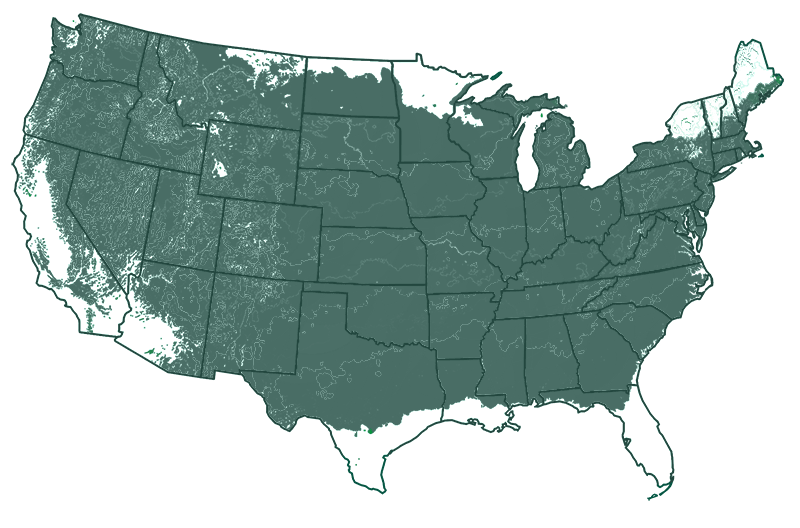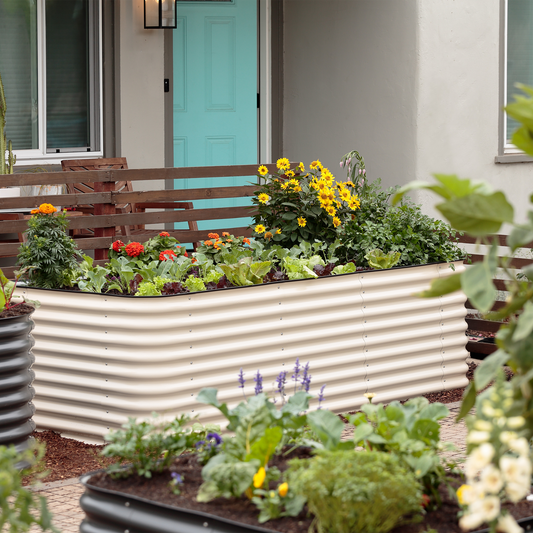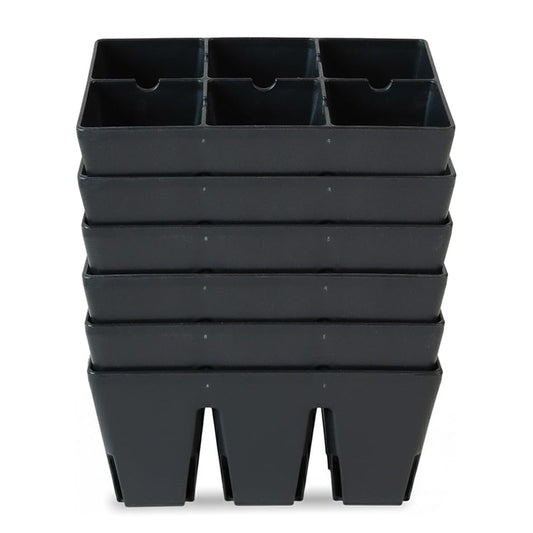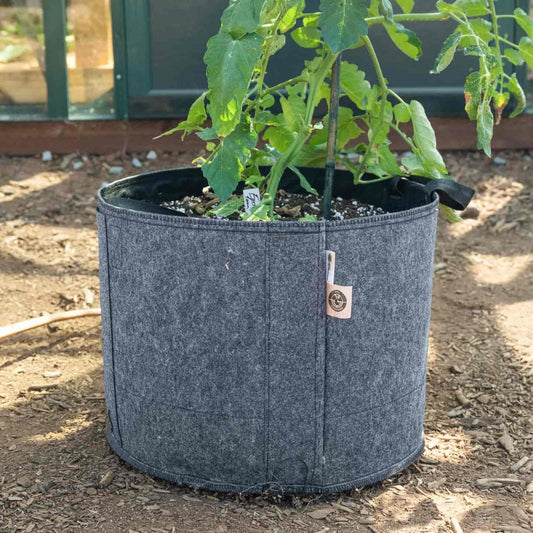
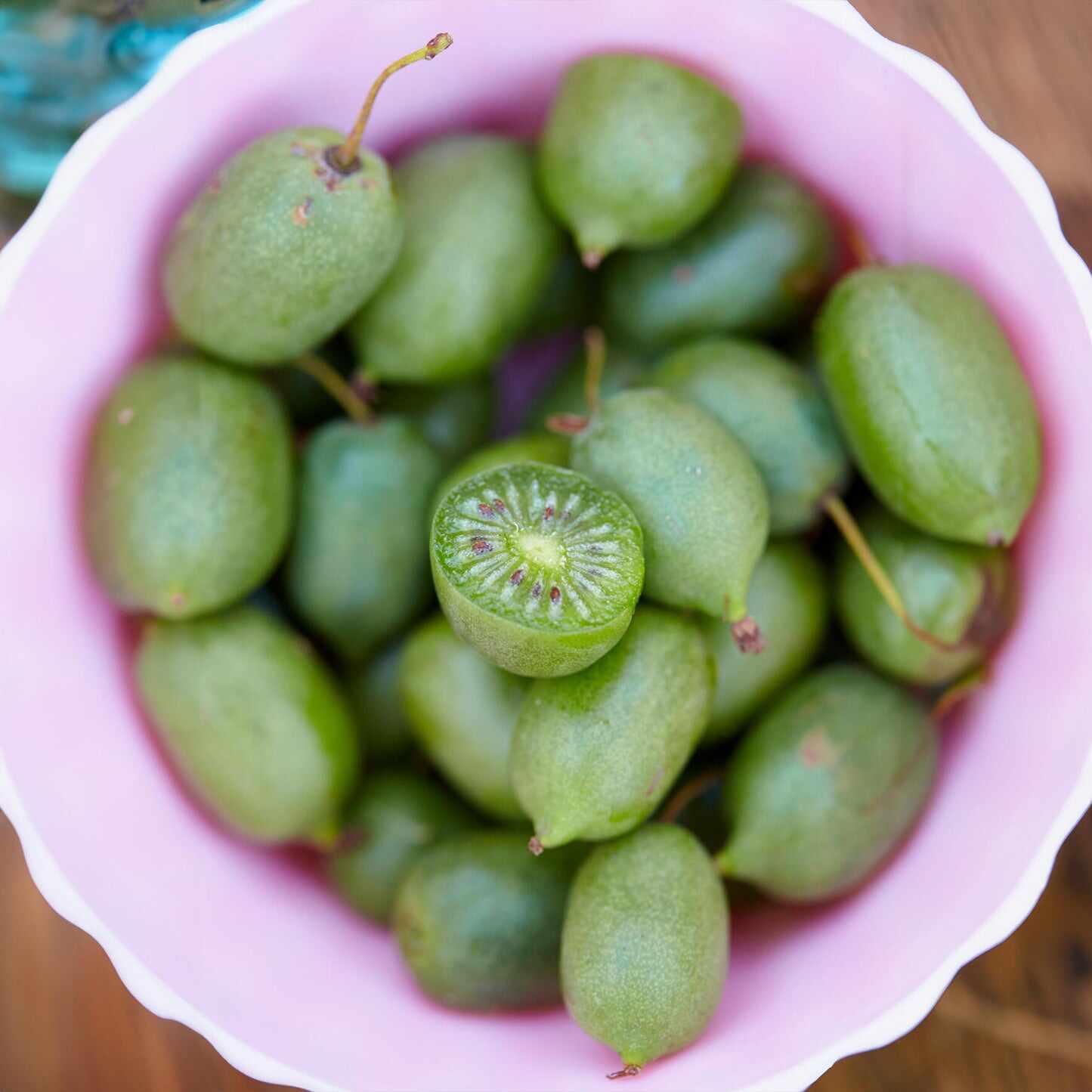
Kiwi - Prolific (Self Fertile)
View More Planting Info
Choose a sunny spot with well-draining soil. Dig a hole twice the width and as wide as the plant's root ball for planting in the garden. Increase fertility and drainage by adding a lot of compost to the planting soil and mixing it in well. Remove the plant from the container and gently tease the roots. Before planting, add any framework needed to support the fine as it grows. Place it in the planting hole and fill it with the amended soil, packing it in as you remove air pockets. Water the plant in a well, and add a layer of mulch around the base to help conserve water and keep weeds at bay. Train the vines up the structure. For planting in containers, choose large containers with plenty of drainage and place them before filling them with soil and your framework so the heavy pots don’t have to be moved. Fill with good potting soil and add compost.
Harvesting:
Harvest when fruits change from green to green with burgundy while still firm. They ripen off the tree.
Pruning:
Prune dead or diseased vine sections, but don’t remove old wood, as this part sets fruit.
Growth:
Prolific Kiwi vines grow 20 feet in-ground, or smaller in containers. Space a few feet from other plants.
- Product Info
- Care and Maintenance
- Planting Care
- Growing Zone
Product Info
Mature Height: 12 ft. in Container
Mature Width: Vine
Sunlight: Full-Part Sun
Growth Rate: Moderate
Does Not Ship To: AZ, OR
Care and Maintenance
Watering: Keep the soil moist for the first year the vines are established. After that, water one to two times a week.
Fertilizing: All this plant needs is an annual feeding with a balanced fertilizer for fruit and flowering in early spring.
Pruning: Fruit develops on the previous year’s growth, so light pruning is essential. Prune to maintain shape and help guide the plant along trellises or support structures.
Pests and Diseases: Few pests and diseases will affect a kiwi vine. Look out for scale insects and snails or slugs. Treat the scale insects with insecticidal soap or neem oil, and drown the snails/slugs in a bucket of soapy water or use an organic snail bait to keep them away from the plant. The active ingredient actinidine, found in members of the Actinidia genus of plants, attracts cats to it, similar to the effects of catnip. A cat rubbing up against the plants can damage new shoots. Gophers and deer may also be attracted to the vines for the same reasons as cats, nibbling at the leaves and eating the fruit. Consider fencing or netting in these circumstances.
Pollination: Kiwi Prolific is self-pollinating and is sometimes used as a pollinator for other varieties of kiwi vines. Increase the occurrence of honey bees by adding flowering annuals planted close to the vines.
Harvesting: Harvest kiwis in the fall when they are large grape-sized and turn from green with a burgundy blush. They will ripen off the vine for a few days if kept at room temperature.
Recovery Time: Transitioning from our nursery to your home can be a bit of a shock to your plant. A short acclimation period helps it recover and reduces stress.
Climate Adjustment: Every environment is unique. Giving your plant time to adjust to the local climate, humidity, and light conditions in a shady spot will set it up for better growth and health.
How to Acclimate Your Plant: Keep the plant in its container and place it in a shady, sheltered area away from high winds. Ensure it's watered adequately – the soil should be moist but not waterlogged. Monitor the plant for any signs of distress and allow it to adjust for a few days before planting. After a few days of acclimation, your plant will be better prepared to thrive in its new home for years to come.
Planting Care
Sunlight: Plant in full sun. In hot climates, plant in full sun with afternoon shade.
Soil: Plant in well-draining soil with a slightly acidic to neutral pH between 5.5 and 7.0. Enrich the soil with plenty of compost, including container plants.
Mature size: It will grow 10-12 feet long in a container and over 20 feet when planted in the ground. Because of its potential size, this is an excellent choice for training over an arbor or arched trellis.
Climate: This is a cold-hardy variety that will grow in temperatures above -25°F (-32°C).
Thinning: Thin to shape and reduce bulk or remove dead or damaged material, but be careful not to prune into old wood, which will be the carrier for fruit in the coming season. Allowing some new green wood to mature to older wood increases the potential fruiting space in subsequent years.
Location: A sunny location in cooler climates is ideal, with afternoon or partial shade in warmer climates.
Watering: Kiwis like plenty of water, about one inch per week. Keep the soil moist, especially when the plants are being established. Mulch the plants to conserve water.
Pruning: Prune the vines to maintain their health, but don’t remove all of the old wood, which is the part that sets fruit. Remove any visibly dead or damaged parts of the vine when necessary.
Spacing: The vines will grow along and fill a framework or trellis, so plant carefully to prevent the kiwi vines from shading out any full-sun plants. Leave some space between the vines and other planting areas.
Harvesting: Harvest when the fruits change from only green to green with a touch of burgundy while still firm. They will ripen at room temperature for a few more days after harvesting.
Pollination: This variety is self-pollinating and doesn’t require a second pollinator plant, although it can sometimes produce a larger harvest if another kiwi is nearby. Bees and butterflies will help with pollination.
Hardiness Zone: The Kiwi Prolific vine is suitable for planting in USDA zones 4-8.
Fertilizer: Fertilize in spring and again midsummer with a balanced fertilizer.
Growing Zone
Grows Well In Zones: 4-8 outdoors
